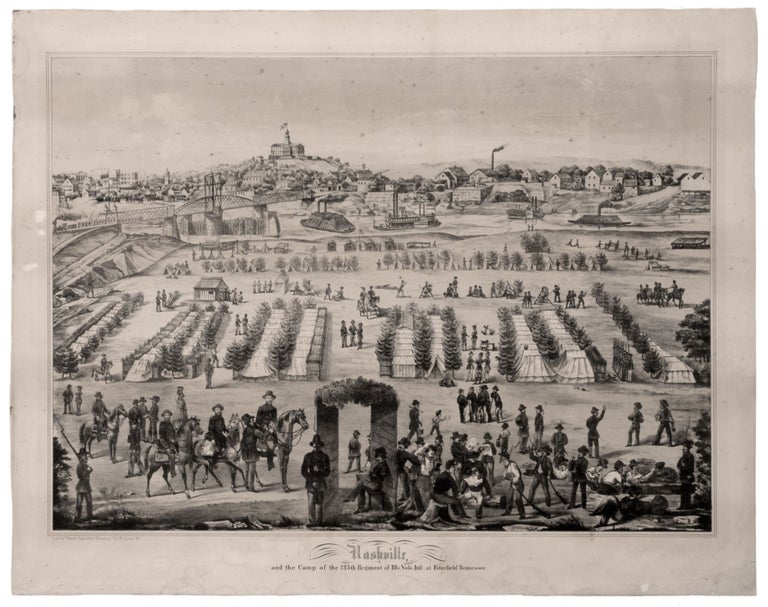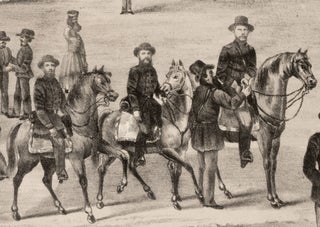Nashville, and the Camp of the 125th Regiment of Ills. Vols. Inft. At Edgefield Tennessee.
19 ½ x 25 inches. Lithograph. Bit of light foxing, light water staining bottom margin, few small marginal mends, near excellent overall with a strong impression. Not only is this very rare view highly important for its early depiction of Nashville, but it is also one of the most remarkable and detailed printed evocations of camp life in the Civil War. Reps in Views & Viewmakers of Urban America lists only three other views of Nashville published before 1900; this one was not recorded by him. The view depicts Nashville from the east bank of the Cumberland River, with the state capitol in its elevated position as the dominant structure of the city. In the river are two Union ironclads and two paddle-wheeled U. S. Mail steamers, one named the Humbold; a swing bridge spans the river. In the foreground is a marvelously detailed composite of the life of a military camp in the Civil War. It is, however, as much a depiction of its social life as of its military functions. In the foreground a figure is receiving the dubious benefits of camp dentistry, while another nearby looks in a mirror while styling his hair. There is a grave digging detail at right; several soldiers exercise on makeshift equipment; a band practices and several groups palaver. Perhaps the homey, leisurely aspect of the encampment was meant to provide comfort for loved ones at home. A notable detail is the few African-Americans scattered throughout the camp, each marked by a sense of isolation. The artist of the view is neither identified nor known. However, as reported in a dealer's description, a descendant of the purported artist has identified this as the work of Johannes Santfleben, a sergeant of the 16th Regiment of the Illinois Volunteers Infantry. We have not been able to confirm this. This is the first of two known states of the view. The perhaps over-enterprising Schrader issued this state, purported to depict the encampment of the 125th Regiment of Illinois Volunteers Infantry, while with little, though meaningful change, he also re-issued the print purporting to depict the 16th Regiment of the above unit. Other than their titles the two states differ in the faces of the officers on horseback to left of center, which clearly have been considerably altered; these three figures were presumably the regiments' senior officers. It is notable that their faces were engraved with greater individuality and refinement than are found on other figures in the views. The visage of the officer just to the left of the trellis in our state of the view matches that of an image we found on line of the 125th's commanding officer (steely gaze and all), Colonel Oscar Fitzalan Harmon (https://www.google.com/search?q=col.+oscar+fitzalan+harman&tbm=isch&tbo=u&source=univ&sa=X&ved=0ahUKEwiGzsX6wNXZAhVxhOAKHbmSDHgQsAQIUw&biw=1680&bih=870#imgrc=9kyV3Ugqx4TtPM:). Thus, Schrader did provide some real value for his "double dip" in the re-publication of this print. We have identified the state with the 125th Regiment to be the first because there is extra spacing in the title of the 16th Regiment state as well as indications of erasure in the title. The 125th Regiment was mustered in Danville, Illinois for three years of service. It was encamped outside of Nashville from November 7, 1862 to June 30, 1863 and returned there once again for another month later that summer. It was a very active unit that fought numerous campaigns in Tennessee and Alabama and then with Sherman through Georgia and on to Richmond. In the course of its service, the Regiment lost over 200 men (out of roughly 1000) including Harmon. We have found only three institutional examples of the print: TN Library & Archives (2nd state), Huntington (2nd state); Brown (1st state). We are aware of only one other example having been on the market.


